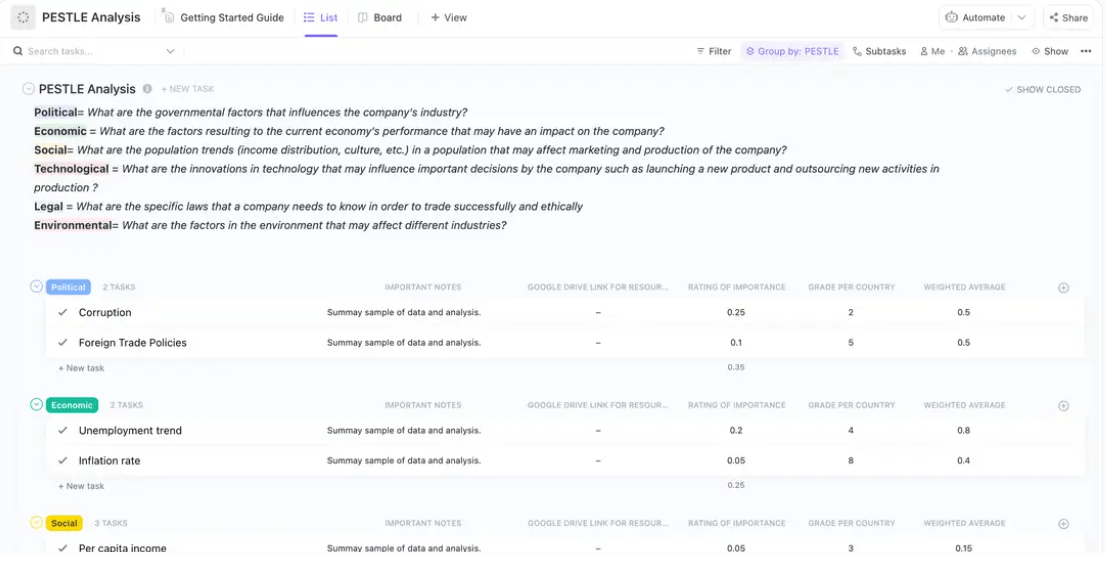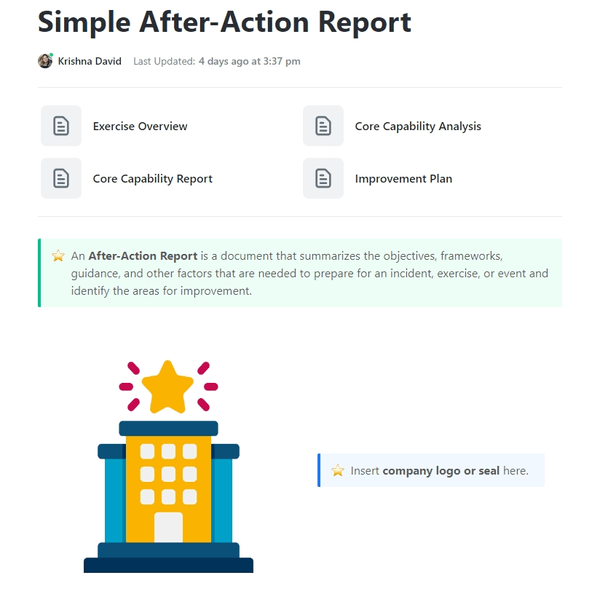What is PEST Analysis? Templates, Definition, and Examples

Sorry, there were no results found for “”
Sorry, there were no results found for “”
Sorry, there were no results found for “”
Seasoned business strategists use ‘PEST (‘political, economic, social, and technological) analysis’ to identify whether a new country, market, or city is the right fit for business expansion.
Plus, as a part of ongoing strategic planning, PEST analysis involves identifying and discovering external forces with significant risks to your business and developing strategies to handle those changes.
Breaking down the causes and potential effects of unexpected changes likely to affect your business helps your team understand what’s happening and build an action plan to fit the technological landscape.
Traditionally, PEST analysis involved writing down the analysis of each economic, social, and technological factor and making assumptions about their changing patterns.
However, whether planning a new product launch or assessing a market for potential threats, new-age affinity diagram tools and a PEST analysis template help make the process easier.
These tools help you constantly monitor and prepare for losses, identify threats, and understand your capabilities in the broader business environment.
This article shares how to perform PEST analysis and the tools to effectively conduct and organize your analysis.
PEST analysis is a project forecasting methodology for business professionals and strategists. PEST looks at external factors like political, economic, socio-cultural, and technological changes likely to impact your business performance and revenue.
Professor Francis Aguilar from Harvard University developed this framework in 1967 to assess how these factors affect a business environment. Analyzing PEST factors helps you identify the potential challenges in the current economic environment and leverage the findings as a competitive advantage.
The different PEST factors include:
By the end of a successful PEST analysis, you will be able to answer the following questions:
PESTLE analysis is an extension of PEST analysis. PESTLE considers all the factors of PEST analysis along with two additional factors—legal and environmental conditions, that might impact your business operations.
What is that one common goal for all businesses, irrespective of the industry they belong to or the product they sell? Usually, it is being profitable, leading the competition, or goals along similar lines.
Now, these goals vary from business to business. However, businesses require a definitive idea about their target market and its preferences before setting the right goals. PEST analysis helps focus on developing an end-to-end marketing plan by analyzing the critical external elements.
Marketing strategists and business professionals require PEST analysis for four main reasons:
Let’s dive deeper into the different scenarios when you should use PEST analysis as a strategic business tool.
PEST analysis is used to understand unexpected changes and proactively evaluate whether a business decision is right for your organization. Some specific use cases where PEST analysis is beneficial are:
Evaluating the change is overwhelming when a business landscape changes drastically without warning and without the right tools.
A PEST analysis breaks down the external economic and political factors and technological, legal, and environmental changes to understand how they will impact your organization and pivot accordingly.
Let’s take a PEST analysis example. During the Covid-19 lockdowns in China, shipping delays impacted most global companies. With PEST analysis, you could extrapolate and predict the impact of the shipment delay on your future strategy.
As PEST analysis focuses on cultural and economic factors when expanding to new geographies, use this framework to gauge cultural differences. In addition, having a person familiar with the new market helps to develop the go-to-market strategy while considering the cultural factors.
For example, Pepsi’s ‘Come Alive with the Pepsi Generation’ campaign was well-received by English-speaking audiences. However, the Chinese version promised that ‘Pepsi brings your relatives back from the dead,’ but it was not a hit. This is a good example of how PEST analysis would’ve helped prevent this cultural error.
Developing a new product involves considerable research ranging from consumer trends to spending patterns and identifying the ideal customer profile (ICP).
A PEST analysis helps you consider the external factors your ICP would consider during their decision-making process.
PEST analysis is useful when you want to analyze the long-term picture of your business from the lens of strategic thinking:
SWOT analysis, another famous market research technique, is often used with PEST analysis to assess the business environment and other technological factors impacting the change. SWOT analysis stands for—Strengths, Weaknesses, Opportunities, and Threats.
Unlike PEST analysis, where your focus is solely on analyzing the external environment of a business, SWOT analysis assesses both internal and external environments.
Strategists use PEST analysis as a mind-mapping tool to analyze a business environment and identify possible threats and opportunities. You need this framework in the ideation phase of a business.
On the other hand, SWOT analysis software is a more project-specific tool that comes into the picture after you have successfully created a business plan. At this stage, you want to identify your internal strengths to address the external threats and weaknesses so you don’t miss out on the external opportunities.
SWOT and PEST analysis work best when implemented together.
Performing a PEST or PESTLE analysis from scratch is time-consuming and resource-intensive. Instead, ClickUp’s PESTLE Analysis Template provides frameworks to understand and analyze the external factors impacting your business environment.

At the same time, using this template, you have identified significant opportunities for revenue growth.
The benefits of using the PESTLE Analysis Template to meet your project objectives are:
Now, let’s discuss how to use this template to perform your first PEST(LE) analysis.
Each environmental factor is associated with multiple elements. If you analyze all these aspects individually, the PEST analysis may take months, even years, to complete. So, the more intelligent strategy is identifying the key aspects highly relevant to your business for each factor.
Suppose you perform a PEST analysis of the macroeconomic factors to understand if you should expand to a new country. Create a project Doc to list all the critical areas for each factor you want to target and factors that might impact your business.

Political factors include the possibility of conflict with other countries, an upcoming election, or special political legislation for international businesses that you should know before starting the project.
The following economic factors to consider are the growth or decline of interest rates and GDP, if there is a significant exchange rate difference, and government policy related to international trade restrictions.
Common socio-cultural factors are consumer buying patterns or preferences and generational value differences that might affect the target market.
Categorize Docs based on tags such as PEST external factors for easy access and searchability. Add necessary resources, guidelines, and company wikis to your Workspace.
Once you collect the data, brainstorm and identify the relevant opportunities and threats. Pairing your PEST analysis with SWOT analysis at this stage will help you.
For example, during the COVID-19 pandemic, brands like Slack noticed the following opportunities and threats:
| Opportunities | Threats |
| A complete shift to remote workplace settings due to frequent lockdowns and the popularity of touchless technologies. | Once the pandemic passes, onsite operations will start again, leading to lesser use of remote technologies. |
At this stage, use ClickUp Whiteboard for collaborative brainstorming. Here’s how Whiteboard is a creative canvas for your team:

At this stage, ClickUp AI streamlines your workflow, whether managing a product release or creating a PEST analysis document for your stakeholders. With ClickUp AI, pull action items from meeting notes and share them with the team, summarize comment threads, and generate project updates for internal and external collaborators.
Based on all the collated data related to all the macroeconomic factors, set your business goals and the specific actions for each goal.
For example, in the above use case of Slack, some of the relevant business goals could be:
To fulfill the above goals, the relevant actions will be:
Also, keep after-action report templates handy to track the actions occasionally and make relevant business decisions.

A great way to make the most of a PEST analysis is to use project management tools to make the information visible to all internal and external stakeholders, collaborate with your team members in real time, and organize this analysis for future reference.
Project managers and business analysts use ClickUp’s project management tool to help everyone stay on the same page regarding external factors that can impact your business.
ClickUp’s PESTLE Analysis Template helps business professionals understand the current and external environment of the business and avoid scope creep.
Start by listing all the external factors on ClickUp Docs, including social factors, and convert text into trackable tasks to stay on top of your ideas.
After this, use ClickUp’s value proposition templates to communicate your offerings, conduct competitive analysis, and develop customer-centric unique value propositions (UVP).
Create tasks for each factor and use ClickUp Goals to stay on track to hit your objectives with clear deadlines.

Convert these plans into actions, break down each action item into multiple tasks, and organize all your tasks in a central ClickUp Dashboard for everyone’s visibility. Get rich insights into the progress of your PEST analysis with line, pie, and bar graphs. Plus, assess the team’s capacity to manage workloads.
Create your first PEST analysis and master the art of gathering data effortlessly.
© 2026 ClickUp